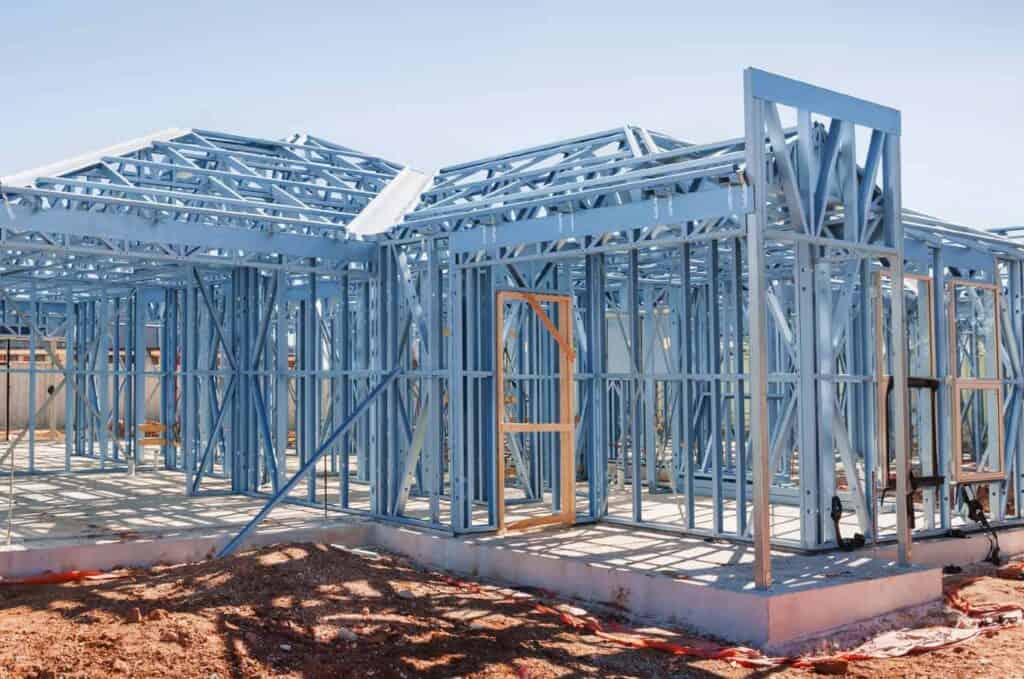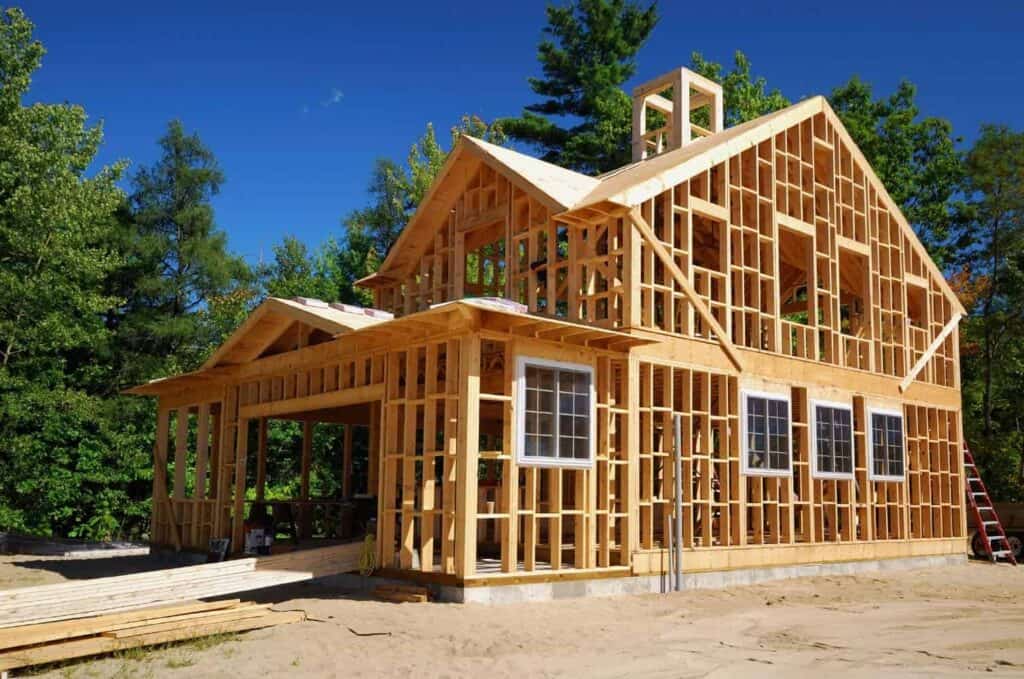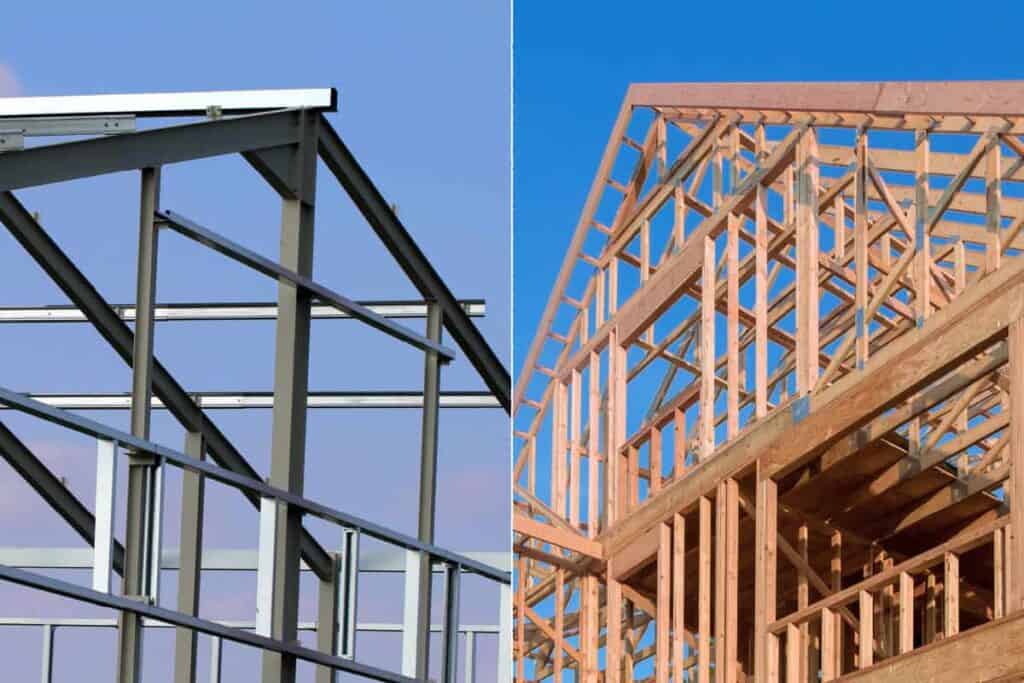Are you planning a home addition? From sunrooms to garage extensions, framing is an essential part of the building’s construction. The frame—or “skeleton”—of the structure is responsible for both holding up the house.
That said, the top two choices for residential construction are almost always wood and steel. So, how do you know which one is the better option for your construction project?
In this comparison guide, we highlight the key differences of steel framing vs. wood framing and cover the pros and cons of each type of framing to help you make the best choice.
Comparison

Wood is the most common framing option, but steel has become increasingly popular for residential construction projects. Both can withstand heavy loads but differ in many ways. Let’s explore each of the differences when considering a framing material.
Cost
When factoring just the framing, steel has a higher upfront cost. Steel also requires special fasteners to assemble. This slows down the construction process, increasing the cost for labor time and materials.
However, the cost of maintenance and repairs for wood over time outweigh that of steel, which is built to last. Considering the two, the cost of the steel and wood framing are relatively the same.
Durability
Both steel and wood framing are very durable, meaning they’re able to bear loads heavier than their weight. However, steel has much higher damage resistance than wood.
Availability
Wood is more readily available than steel, and you can purchase lumber from any home improvement store. While steel has recently appeared in some stores, you’d have to purchase significant amounts directly from a steel distributor.
Integrity
As mentioned earlier, metal is more resistant to damaging agents such as weather and insects. Wood, on the other hand, can warp, rot, crack, and shrink from exposure to those same elements after a few years.
Sustainability
Steel and wood are recyclable and reusable. The only exception is in how they are produced. While wood is a natural and renewable resource, lumber companies don’t always implement sustainable forest harvesting practices. Similarly, some production processes within the steel industry are responsible for hazardous air pollutants.
Versatility
Wood trumps steel in the versatility factor since it’s easier to fix and modify as needed. Steel, on the other hand, is difficult to cut.
Steel Framing: Pros and Cons

Steel framing studs typically get used in commercial construction, but they’ve become increasingly popular with residential structures due to steel’s sustainability. Nowadays, steel primarily gets used for large simple buildings, such as garages, warehouses, and barndominiums.
You may appreciate the lightweight and perfectly smooth surface of steel, having zero cracks compared to wood—and it’s also extremely strong and durable. It’s unlikely to crack and can last for years without needing repair. Rust is a concern if building in a coastal environment, but when coated with anti-corrosive material, you can prevent it. Best of all, steel is resistant to termites and many other hazards, making it fortified in case of natural disasters.
One concern when considering steel is finding an expert in metal framing. There are much fewer contractors with experience in steel than with wood. This is because steel frames get primarily used in commercial construction and rarely for residential.
Another drawback is that it is more difficult to make changes or alterations once steel frames are assembled. This makes upgrading electricity, plumbing, and other necessities a bit more complex and expensive.
| Pros | Cons |
| Warp- and rot-resistant | Not a good insulator |
| Fire-resistant | Heat conductor |
| Pest-resistant | Less flexibility |
| Lightweight |
Wood Framing: Pros and Cons

Lumber is the most simple and commonly used material for framing residential structures. It’s available at any home or hardware store, and most professional contractors have experience with wood frames and are familiar with its construction codes.
Wood’s greatest asset is its flexibility, where it is easy to reconstruct, redesign, shorten, and extend as needed. This also makes wood framing easier to fix internally and externally.
Like steel, wood is also durable and can support a lot of weight. This, however, is only when it’s dry. When exposed to moisture, it can warp and rot. Wood also may require more maintenance, as it is susceptible to pest and insect infestation. You can spray treat lumber to prevent termites and mold, but this doesn’t last a lifetime. Last but not least, wood frames may creak and loosen over time.
| Pros | Cons |
| Readily available | Flammable |
| More contractors skilled with it | Can warp & rot from moisture |
| Versatile | Susceptible to pest/insect infestation |
| Doesn’t conduct electricity | |
| Natural insulator |
Frequently Asked Questions
Is steel framing better than wood?
Steel is stronger and lighter than wood and has more resistance to elements. It also lasts longer and requires less maintenance than wood framing.
What are other material options for framing?
While lumber and steel are the most popular framing studs, traditional brick, concrete masonry units (CMUs), and insulated concrete forms (ICFs) are other building materials you can use.
What are the disadvantages of steel framed houses?
Steel can rust and corrode in coastal areas or near large bodies of water. Also, it isn’t energy-efficient—you may need to add more insulation to metal buildings to regulate the temperature inside.
Steel vs. Wood Framing: How to Choose
When choosing between steel and wood framing, it’s best to factor in the location, type of structure, and intended use. After that, the decision ultimately lies in whatever is best for your budget.
If you’re leaning more toward steel frames for your next garage or storage shed addition, look no further than our steel buildings. Durable and low-cost, our prefab structures are quicker to assemble than building on-site. Customize and order your new steel building using our 3D design tool below.
Sources:
- Steel Framing Alliance. “A Builder’s Guide to Steel Frame Construction,” n.d. http://www.steelframing.org/PDF/quicklinks/SFA_Framing_Guide_07.pdf
- Falk, Robert H. “Wood as a Sustainable Building Material.” US Forest Service Research and Development, 2010. https://www.fs.usda.gov/research/treesearch/37431#.
- US EPA. “Integrated Iron and Steel Manufacturing: National Emission Standards for Hazardous Air Pollutants | US EPA,” May 9, 2023. https://www.epa.gov/stationary-sources-air-pollution/integrated-iron-and-steel-manufacturing-national-emission.




